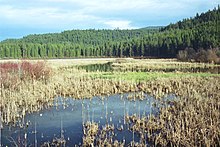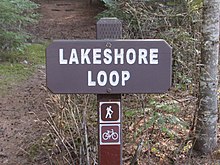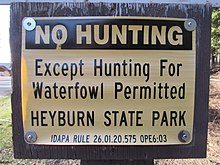Contents
Heyburn State Park is a public recreation area in the U.S. state of Idaho. It is located almost entirely in Benewah County, with a small portion extending into southern Kootenai County. The park was founded in 1908 and is the oldest state or provincial park in the Pacific Northwest.[3][4] The park has 5,744 acres (23.2 km2) of land and 2,332 acres (9.4 km2) of water on three lakes: Benewah, Chatcolet, and Hidden. A dam constructed on the Spokane River in Post Falls in 1906 raised the level of Lake Coeur d'Alene, connecting it to the park's three lakes.[5] The surface elevation of the lakes is 2,125 feet (648 m) above sea level.[6] The park's year-round recreational opportunities include camping, boating, hiking, horseback riding, fishing, and picnicking.[2]
History
The Coeur d'Alene were the first inhabitants in what is now Heyburn State Park. Originally members called themselves, "Schitsu'umsh," meaning "The Discovered People" or "Those Who Are Found Here."[7] The Natives found an abundance of fish in the three lakes of the park as well as in the Saint Joe River. Waterfowl inhabited the wetlands and deer, bear and various birds were plentiful in the grassy meadows and slopes of the surrounding mountains.[2] Prior to the arrival of European American settlers, the Coeur d'Alene lived in what would become the Idaho Panhandle. The first Europeans to encounter the Coeur d'Alene were French traders and trappers.[8] They found the tribe to be experienced and skilled at trading, thus the name "Coeur d'Alene," meaning "heart of the awl." One French trader described the tribe as "the greatest traders in the world."[8] The tribe ranged over an area of over 4 million acres (16,000 km2) of grassy hills, camas-prairie, wooded mountains, lakes, marshes and river habitat in northern Idaho, eastern Washington and western Montana.[8]
The Coeur d'Alene lands were reduced to approximately 600,000 acres (940 sq mi; 2,430 km2) in 1873 when President Ulysses Grant established the Coeur d'Alene Indian Reservation. Successive government acts trimmed their property to 345,000 acres (540 sq mi; 1,400 km2)[7] Heyburn State Park was formed from 5,500 acres (22 km2) of land and 2,333 acres (9.44 km2) of water that were taken from the Coeur d'Alene on April 20, 1908 when President William H. Taft deeded the land to the state for the creation of Heyburn State Park named for U.S. Senator Weldon Heyburn of Idaho.[2] Heyburn had envisioned Chatcolet National Park, which passed the Senate but stalled in the House.[5]
Construction of many of the park's facilities was performed during the Great Depression by the Civilian Conservation Corps.[9][10][11] Members at Camp SP-1 built a lodge, roads, bridges, trails, picnic areas and shelters and campgrounds; many are still in use.[2]
Ecology
Heyburn State Park is home to a variety of habitats. Ponderosa pines, some over 400 years old, are on the mountain sides overlooking grassy hills that are covered with wildflowers. Other trees in the park included cedar, hemlock and white pine. The margins of the lake are marshy homes to wildflowers and plants.[2]
Activities and amenities
The 72-mile (116 km) Trail of the Coeur d'Alenes bike trail passes through the park, crossing the Saint Joe River on a 3,100-foot (940 m) trestle. The river and Hidden Bay, Chatcolet Lake, and Benewah Lake, all sections of the larger Lake Coeur d'Alene, are used for boating, water sports, and fishing. Common game fish include bass, pike and pan fish. The park's marina offers a boat launch, fuel dock, and supplies.[2]
Plummer Creek Marsh

The Plummer Marsh is a short walk along a boardwalk scattered with information kiosk, viewing blind, and benches. This boardwalk provides an opportunity to enjoy the luscious ecosystem the low-lying wet lands and grassy vegetation while taking pleasure in the scenery of the St. Joe Baldy, Reeds Baldy, and Huckleberry Mt.
Birding

A large variety of birds can be spotted in various locations inside the park, ranging from small to large species and depending upon the time of the year will provide a birding experience worth experiencing. It is common to observe a Great Blue Heron rookery consisting of 35-50 pairs of breeding herons in the park during the Spring months. The summer months will produce the experience of observing Osprey, Wood Ducks, Canada Geese, Red-necked Grebes and Soras. The most abundant species of fowl are the American Wigeon, Mallards, and Canada Geese, all of whom make Heyburn State Park their year round residence. It is said there are "several records of vagrant birds here including Eurasian Wigeon, Swamp Sparrow, White-throated Sparrow, Bewick’s Wren, Greater Scaup, and even a record of an Ancient Murrelet."[12]
Trails
Several different types of trails are offered for exploring depending on your preference. Bring your mountain bike to ride the trails in the forest, or an electric bike for enjoying a smooth ride on the paved Trail of the Coeur d' Alenes, There are also trails specific to horse riding and hiking.
All trails within Heyburn State Park include:[13]
- Indian Cliff Trail: 3 miles
- Lakeshore Loop Trail: 0.6 mile
- Whitetail Loop Trail: 8.6 miles
- Scout Out Loop Trail: 2 miles
- Shoeffler Butte Loop Trail: 3.4 miles
- Gandy Dancer Trail: 5.9 miles
- CCC Nature Walk: 1.3 miles
- Rocky Top Loop Trail: 9.6 miles
- Ponderosa Ridge: 12.8 miles

Marina
Rocky Point Marina offers a ADA boat ramp for use.
Overnight Options
Heyburn offers various overnight recreation opportunities for those looking for tent camping, RV hook-up to water and electricity, in addition to dry cabins/cottages. Limited spaces for ADA.[12] Be prepared to pay a fee for day use areas, campsites, and/or have your Idaho State Parks Passport sticker displayed on your vehicle. Fees vary depending on state residency.[14]
ADA Accessibility
- ADA Boat Ramp
- ADA Cabin
- ADA Playground
- ADA Restroom[citation needed]
Hunting and Fishing
Idaho's first state park protects the animals that live within its boundary from hunting with the exception of the waterfowl. This is due to the abundance of waterfowl species who call the park home. In order to keep the numbers at a healthy balance with their habitat hunting is allowed according to the IDAPA 26.01.20.575, “Rule on Protection of Wildlife in State Parks,” in order to expand recreational opportunities in parks where it is appropriate, as well as assist wildlife managers in achieving population objectives.[15]

A 300-foot safety zone may be designated around trailheads and park facilities by the park manager during established hunting seasons. Shooting off the docks and beaches are not allowed.[12] Although Heyburn State Park is approved for hunting by the Board, hunting might only be allowed in limited circumstances by park rule, therefore it is important to check with the park headquarters prior to engaging in the activity.[15] Bird blinds can be used and need to be removed the same day.
Heyburn State Park offers anglers an opportunity to catch different species of fish, both offshore and from a boat. Each watercraft is subject to an inspection for invasive species. Idaho law requires that any motorized or non-motorized boat operating in Idaho requires an Invasive Species Sticker.[16]
See also
References
- ^ a b "Heyburn State Park". Geographic Names Information System. United States Geological Survey, United States Department of the Interior.
- ^ a b c d e f g "Heyburn State Park". Idaho Parks and Recreation. Retrieved October 29, 2017.
- ^ a b "History: State Lands in Idaho". Idaho Museum of Natural History. Retrieved October 29, 2017.
- ^ "The Early Days: 1910 - 1935". BC Parks. Retrieved September 27, 2019.
- ^ a b "Heyburn State Park". Outdoor Idaho: State of Our Parks. Idaho Public Television. Retrieved October 16, 2015.
- ^ "Benewah Lake". Idaho Department of Fish and Game. Retrieved November 19, 2018.
- ^ a b "History". The Coeur d'Alene Tribe. Retrieved November 19, 2018.
- ^ a b c "Culture: Ancestral Lands". The Coeur d'Alene Tribe. Retrieved November 19, 2018.
- ^ "Heyburn State Park has beauty". Spokesman-Review. Spokane, Wash. August 6, 1937. p. 7. Retrieved October 16, 2015.
- ^ "New facilities ready at Heyburn State Park". Spokesnan-Review. Spokane, Wash. June 21, 1960. p. 6. Retrieved October 16, 2015.
- ^ Slade, Lou M. (July 22, 1962). "Heyburn has sylvan beauty". Spokesman-Review: Inland Empire Magazine. Spokane, Wash. p. 7. Retrieved October 16, 2015.
- ^ a b c "Parks and Recreation of Idaho".
- ^ "Best Trails in Heyburn State Park". All Trails.
- ^ "Heyburn State Park Fees". Idaho Parks and Recreation. Retrieved April 18, 2023.
- ^ a b "Idaho Park and Recreation Quarterly Meeting" (PDF). parksandregistration.idaho.gov.
- ^ "Idaho Invasive Species Program". parksandrecreation.idaho.gov. 2023.
External links
- Heyburn State Park Idaho Parks and Recreation
- Heyburn State Park Map Idaho Parks and Recreation

